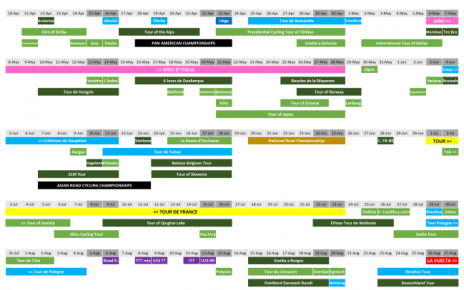Li Tao, or Harry Li, graduated in religious studies from the elite Peking University and learned his near-perfect English watching BBC’s Top Gear. Avid amateur racer and cycling buff, he then spotted a niche – there were no specialised cycling commentators in the country, and so he became the self-taught voice of Chinese road cycling. Li, who continues to work as a race commentator, offers his insights into Chinese cycling fans and amateur races in China.
Li, 30, discovered cycling as a student.
“Peking University has the oldest university cycling association in China, we all watched foreign broadcasts of big races. I also raced a lot, did quite well and got sponsored,” he said.
Through his sponsors, he then became involved in media work. The break came in 2013 when Ji Cheng became the first Chinese to take part in Giro de Italia, which led to the race being transmitted live in China. Li was picked to commentate.

In 2015, a new Chinese media company, LeSports, bought live broadcasting rights for all the major pro road racing events and hired Li. From 2015 to 2016 he did a whopping 120 broadcasting days, becoming China’s first full-time cycling commentator.
Initially, between 20 and 30 thousand people tuned in, but in two years he commanded an audience of more than 100,000.

In 2017, LeSports went out of business and Chinese cycling audience lost access to live race coverage. Some resorted to hacking into broadcast signals and putting races, with no commentary, on to live streaming platforms.
Now Li is with a media company China Sports, who recently bought broadcast rights for the world’s major cycling events. He is “still the only professional cycling commentator in China”.
To be professionally successful, Li had to tune into the needs of Chinese audience who did not grow up with cycling.
Haute Route’s China launch a success despite ‘growing pains’
“I learned by watching commentaries in English, but in China, unlike in the UK or France, you cannot just go straight into race tactics,” he said. “Some Chinese viewers watch because they like certain riders, some like the equipment, not all understand race tactics and format. I try to cover everything in my commentary. New spectators are added all the time, and I do my best to educate them about the sport.”
The new spectators are recruited from the growing pool of Chinese amateur riders which Li estimates to be as high as 50,000,000. He puts the number of competition-level athletes at around one million. Most, he said, prefer simple one-day races, of which there are now more than 1,000 a year in China.
Li said that the growth of Chinese amateur cycling was different from the well-documented Chinese running boom.

“Most runners who do races in China are men who started running after 30, but most competition riders are unmarried men under 30. After they have a family, they have less money and also less time,” Li said. “Almost anyone can run a 10km then a marathon, but you cannot do this with cycling – you need to learn how to ride in a race, and this takes a lot of time. Also riding can be dangerous and equipment can be very expensive.”
Chinese amateur cycling races have been evolving.
“The races used to all very similar, and the only solution the organisers had [to attract riders] was to put up a lot of prize money – the winner would take home as much as 30,000 yuan (US$4,200, HK$33,000). This created a group of several dozen riders who were amateurs but actually lived a pro lifestyle – nothing like this happened anywhere else in the world. They raced dangerously because they were fighting so hard.”
But the Chinese racing scene is now changing and diversifying.

“Different races are appearing now, very interesting and challenging multi-day events like Tibet Challenge (multi-day race from Chengdu to Lhasa), and now also Haute Route. It is not just about prize money any more, average riders are trying to challenge themselves, improve their results.
“Four or five years ago the demand [in the cycling market] was growing very fast, but now the supply in equipment, races, is growing even faster. Many businesses also realised that growth is not as fast as they expected,” Li said. “Some have been folding.”
Li predicts that “Chinese amateur cycling is growing and will continue growing, but races must find a “te dian”, a special something, to attract riders and succeed. For me, the task is to turn those riders into cycling spectators.”



